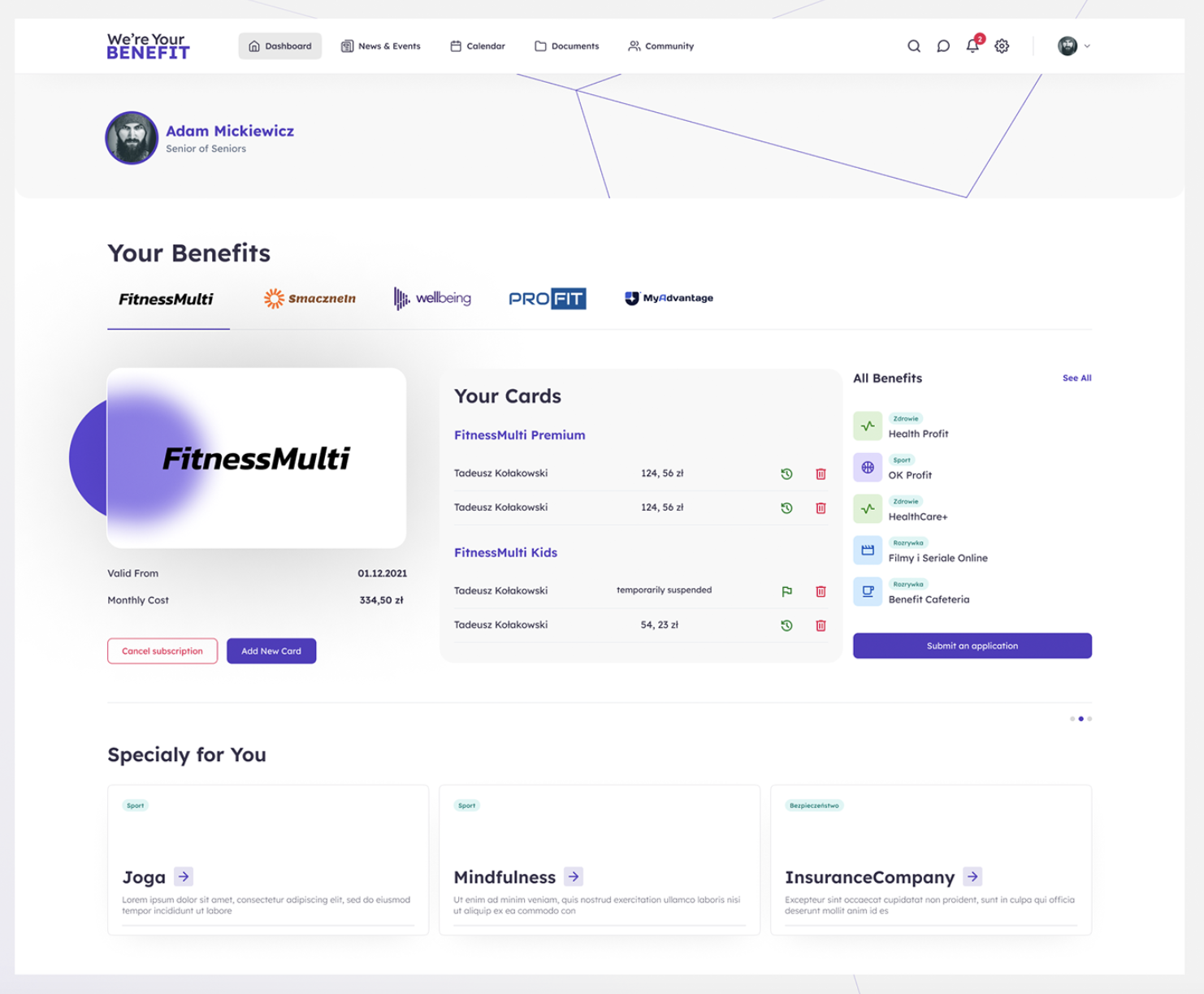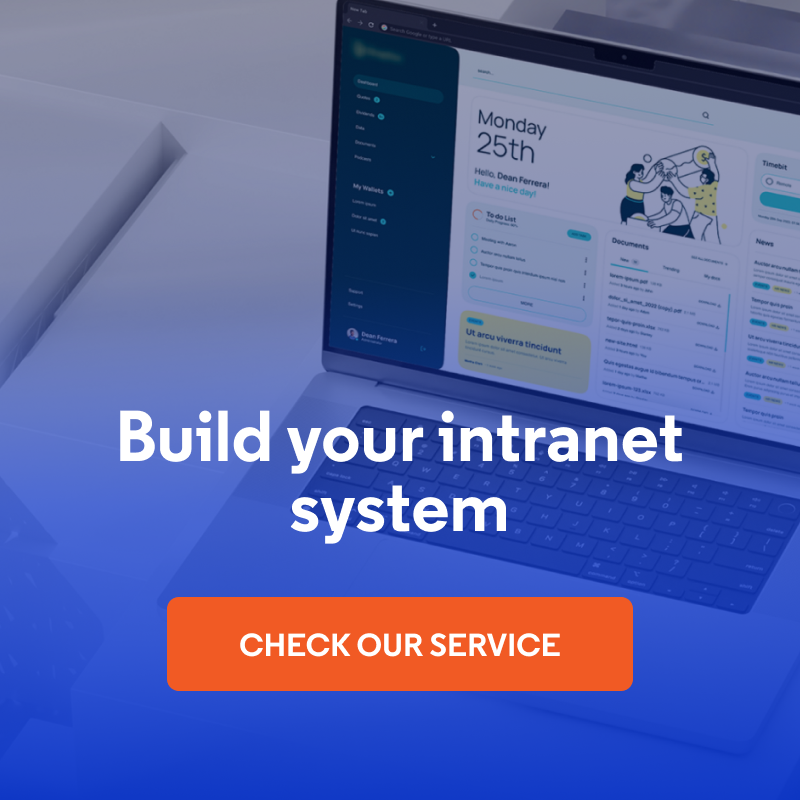
12 Intranet Benefits - Improve Your Business and Engage Employees
There are many reasons for an organization to have an intranet. Such an internal system allows a company to streamline business processes, but most importantly, it makes it easier for teams to perform their daily tasks, systematizes employees' knowledge, provides a convenient way to communicate, and much more. Learn about 12 benefits of an intranet.
What is intranet and its benefits?
An intranet is a private, secure network for sharing information and tools within an organization. Unlike the internet, which is accessible to the public, an intranet is restricted to authorized company users. The system is a central hub for internal communication, collaboration, and information management, allowing employees to access company resources. It fosters a cohesive and efficient work environment.
Below, you'll find specific intranet benefits for which you should consider using this platform in your organization.
1. Streamlined project management and teamwork
One of the key benefits of an intranet is its ability to help teams collaborate and cooperate. Intranets are virtual places where teams can work on projects, use document sharing, and communicate with each other in real time. This improves project management by ensuring everyone is on the same page. It also reduces miscommunication and delays.
Team members can efficiently coordinate their actions with intranet features such as shared task lists and document libraries. Project managers can assign tasks, set deadlines, and follow the activity, all within the intranet. This keeps everyone informed and promotes accountability and transparency.

An example of an intranet project management panel designed by Droptica designers, source: behance.net/droptica
One specific benefit during a typical workday is the ability to track start and end times. The implemented calendar lets employees and managers know who is available and can distribute tasks effectively.
Another example of intranet benefits is that a project manager can easily track the progress of a project on specific tasks. And if it turns out that the task hasn't been marked as completed or doesn't have the status "in progress" for some reason, the manager sees it immediately and can contact the appropriate person.
What else? By exporting specific information from the intranet platform, the manager can then perform an analysis related to a particular employee's work or the context of a project. This knowledge can be invaluable for planning and improving management in the future.
2. Time savings in general
Time management is one of the most important elements of any business process. The better you manage it, the more productive your employees will be. Successively reducing the time spent on individual tasks and looking for improvement opportunities among them is the way to practical improvement of the mentioned processes.
An intranet system is a tool that facilitates this. How to do it? It's enough to start with something as mundane as e-mail correspondence. Checking the inbox, replying to messages, and searching for important attachments. The list is long.
What if you could replace it with a common area that everyone can access and where changes in the document flow are transparent? Quick access to information and efficient updating of the status of a given business process, i.e. information management, is provided by the intranet platform.
Email is not only the correspondence between users but also the newsletter. It takes time to set up, address specific recipients within the company, and send. Moreover, if this newsletter is essential for the life of the organization, the certainty that each recipient has received and read it means waiting.
In an intranet, you can simplify the distribution of the newsletter. Instead of sending such a message, the administrator can indicate a place with an important message and also have functionality that informs about reading this content. The added value for employees is also that it takes less time to find and re-read the newsletter than scrolling through hundreds of emails in the inbox.
3. Better internal communication within an organization
As mentioned in the newsletter example above, an intranet allows you to quickly and easily share information with employees at all levels of the organization. This can include company news, management updates, project information, or important announcements. This promotes transparency and keeps all team members up to date. On the intranet, you can publish different content types, such as running an internal blog. Tagging posts makes it easier to find a particular topic.

An example of a view for adding a new article to an intranet
Communication is also about the flow of information in both directions. In order for employees to cooperate efficiently, they must at least know the availability of team members. It's a good idea to implement a calendar in the intranet system, where each employee can inform others about planned days and hours of work or submit vacation requests. It's a very effective way to improve the management of a particular business project. It is then known which person is assigned to certain tasks.
Every employee can have their own profile on the intranet, which includes the history of all their affairs, and the correspondence with the management.
4. Quick access to the company values and information
A modern intranet makes it possible to create, collect, and easily search relevant information and corporate knowledge. This allows employees to quickly access the resources they need, such as manuals, procedures, or a corporate FAQ page, which promotes a better understanding of organizational information and company values.
I don't think there's any need to convince you that this is a clear benefit of an employee intranet.
Instead of emailing each other updated versions of files, creating new directories on Google Drive, and accidentally sharing them with an unauthorized person, all these things can be "closed" with a well-functioning intranet. This applies to the aspect of business processes and projects that team members are working on.
The intranet also supports the Human Resources aspect. The guidelines published on the intranet and an efficient search engine can effectively support everyone who needs to quickly find the content they are interested in.
The HR scope, which is sometimes very large (regulations, application forms, instructions, etc.), should also be organized in a way that allows the user to navigate it. For example, each instructional video, or even print screens that illustrate how to fill out a given form, saves time and avoids unnecessary involvement of third parties.
5. Simplified employee onboarding and training
Another crucial benefit of a company intranet is the improvement of employee onboarding and training processes. New hires can access all necessary training materials, company policies, and onboarding documents through the intranet. This centralized repository ensures that new employees have all the information they need from day one, facilitating a smoother transition into their new roles.
A modern intranet can host a variety of training resources, including videos, tutorials, and interactive courses. This not only standardizes the training process but also allows employees to learn at their own pace. Managers can track progress and ensure that all employees are meeting their training requirements.
In addition to onboarding, knowledge-sharing intranets support continuous learning and professional development. Organizations can create an extensive library of resources, including industry news, webinars, and practical tools. Employees can use these materials to stay on top of the latest trends and enhance their skills, contributing to their personal growth and the company's overall success.
6. Increased employee engagement and satisfaction
Employee engagement is critical to the success of any organization, and intranet platforms play an important role in improving it.
Recognition and reward programs
One of the benefits of an intranet is the ability to implement recognition and reward programs. You can manage these through the intranet, allowing colleagues and managers to publicly recognize outstanding performance. This fosters a culture of appreciation and motivates employees to excel in their roles. Nothing increases engagement more than being recognized by a manager and/or peer.
Surveys
Every survey, and therefore feedback, has value. Both when it comes to answers to questions about how employees perceive the organization and how they are perceived in the organization. Surveys conducted on the company intranet can be a quarterly, semi-annual or annual assessment of the employer and the employee. They are particularly valuable for organizational culture because they take place as a cyclical process (and this is the distinguishing feature), and secondly due to the fact that both parties gain information about themselves. The added value here is transparency, the building of further mutual trust, and the space for improving the working environment.
Social interaction and community building
Modern intranet acts as a social platform where employees interact beyond work-related tasks. Features like social feeds, group chats, and interest-based forums help build a sense of community within the organization. Employees can share achievements, celebrate milestones, and engage in informal conversations, strengthening workplace relationships and boosting morale.
Innovations in the company culture
Using the feedback mentioned above and the modern intranet as a communication platform can effectively influence identifying needs and implementing innovations. Every new idea and suggestion can be discussed and analyzed to meet the expectations of the interested parties. The benefits of such an approach are incomparably greater than when management decides on a change without any prior consultation. Unfortunately, the costs of this type of action may be too high and the goals may not be achieved.
7. Better work-life balance and employee retention
Intranets can be a real game changer for work-life balance initiatives. They provide tools that enable flexible work arrangements. Employees can log in from anywhere, allowing them to work remotely or adjust their hours to better fit their personal lives. This kind of flexibility can really boost job satisfaction and help keep turnover rates low.

An example of an intranet with access to benefits such as yoga, mindfulness, or insurance, source: behance.net/droptica
Health and wellness programs
The corporate platforms are also great for promoting health and wellness programs. They can host a variety of resources, from fitness challenges and mental health support to nutrition tips and stress management tools. Easy access to these materials can really improve employee well-being and create a “healthier” workplace overall.
8. Cost reduction
The intranet can help you cut administrative costs. It offers email, newsletters, real-time updates of important documents, quick access to information, and online meetings, with a big emphasis on the mobile version. Thanks to this, you can organize a video call with employees no matter where they are, and that allows you to manage the business process more efficiently.
Moreover, by centralizing communication and document management, the intranet reduces the need for paper documents and physical storage, resulting in savings on printing and archiving costs. Automating repetitive tasks and workflows means you don’t need extra administrative staff, which means more cost savings.
Furthermore, by having all business applications in one intranet software, you don't have to maintain several separate systems, which means a leaner and more cost-effective IT infrastructure. Overall, the intranet helps to make better use of resources and be more productive, which significantly reduces overall business costs.
9. Improved security and compliance
Security is critical for any organization, and a modern intranet provides a safe space to manage documents. Unlike some external communication tools, this platform offers controlled access to sensitive information, ensuring that only authorized individuals can view or edit important files. This greatly reduces the risk of data breaches and helps keep the company's valuable information safe.
Compliance tracking and reporting
An intranet platform also makes it easier to stay on top of regulatory compliance. You can keep all your compliance documents in one place, track how well policies are being followed, and quickly generate reports when needed. This centralized approach makes audits much easier and helps ensure that the company is meeting all its legal and regulatory obligations, avoiding potential fines and legal issues.
10. Advanced decision making
One of the great things about using an intranet is that it gives you real-time access to all the critical business information you need. This means that managers and employees can make smart decisions quickly. Whether you're looking at sales figures, project updates, or customer feedback, having this information at your fingertips ensures that you're always working with the latest data.
Better reporting capabilities
Intranets can also generate detailed reports that provide insight into different parts of the business. You can customize these reports to track things like project progress, employee performance, or financial health. With these enhanced reporting tools, companies can spot trends, anticipate challenges, and seize opportunities-which is great for strategic planning and decision-making.
11. Crisis management
Effectively managing a crisis is critical for any organization, not only to ensure the safety of its employees but also to keep operations running smoothly. An intranet can be a lifesaver in such situations.
Emergency communication
In the event of a crisis (such as a hacking attack or data leakage), a reliable communication tool is essential. An intranet allows organizations to quickly share instructions with all employees, ensuring that everyone is in the loop and knows what to do. This rapid communication can help mitigate the impact of the incident.
Business continuity planning
Intranets are invaluable for business continuity planning during disruptions. They give employees access to critical information and resources, allowing them to communicate with colleagues and, if necessary, continue working remotely. This helps the organization stay operational and quickly recover from unexpected events.
12. Customizable and scalable solutions
Every business is unique, and an intranet can be shaped to fit those specific needs. From the overall look and feel to the functionalities it offers, an intranet can be customized to match a company’s brand and objectives. This level of personalization ensures that the intranet is not just another tool but a valuable asset that aligns perfectly with the organization’s goals.
Scalable for growth
As your business expands, your needs will change. Modern intranets are designed to be scalable, growing alongside your organization. Whether you need to add more users, introduce new features, or integrate with external tools, your company intranet can adapt to these changes. This flexibility ensures that your intranet remains useful and effective, no matter how big your business gets.
Integration with other systems
Today’s intranets don’t operate in isolation. They can integrate seamlessly with other enterprise systems like CRM and ERP software. This means data can flow smoothly between systems, cutting down on redundant data entry and boosting efficiency. With everything accessible from one platform, employees can work more productively and make better decisions.
Intranet benefits - summary
There are no doubts about the benefits of an intranet in place. From enhancing internal communication and collaboration and improving employee engagement to ensuring security and enabling workflow automation, the advantages are extensive.
When planning the internal platform creation, it’s important to identify the company's needs and build an intranet based on the goals it is to achieve. Seeing the changes it has caused over time, an intranet should be improved to use its capabilities in the most effective way. The benefits of an intranet are clear, and investing in a well-designed intranet can significantly enhance business operations and employee satisfaction.












